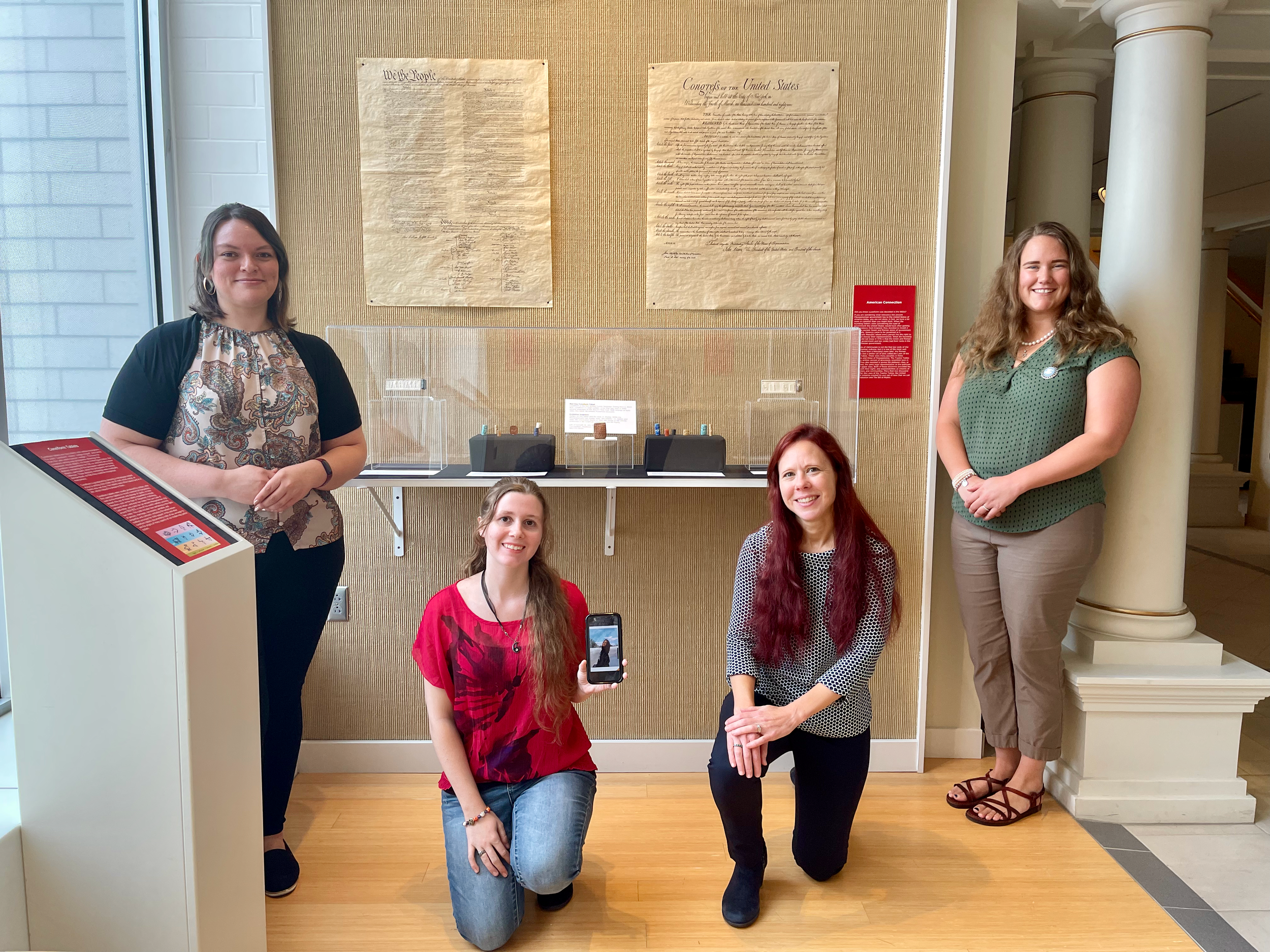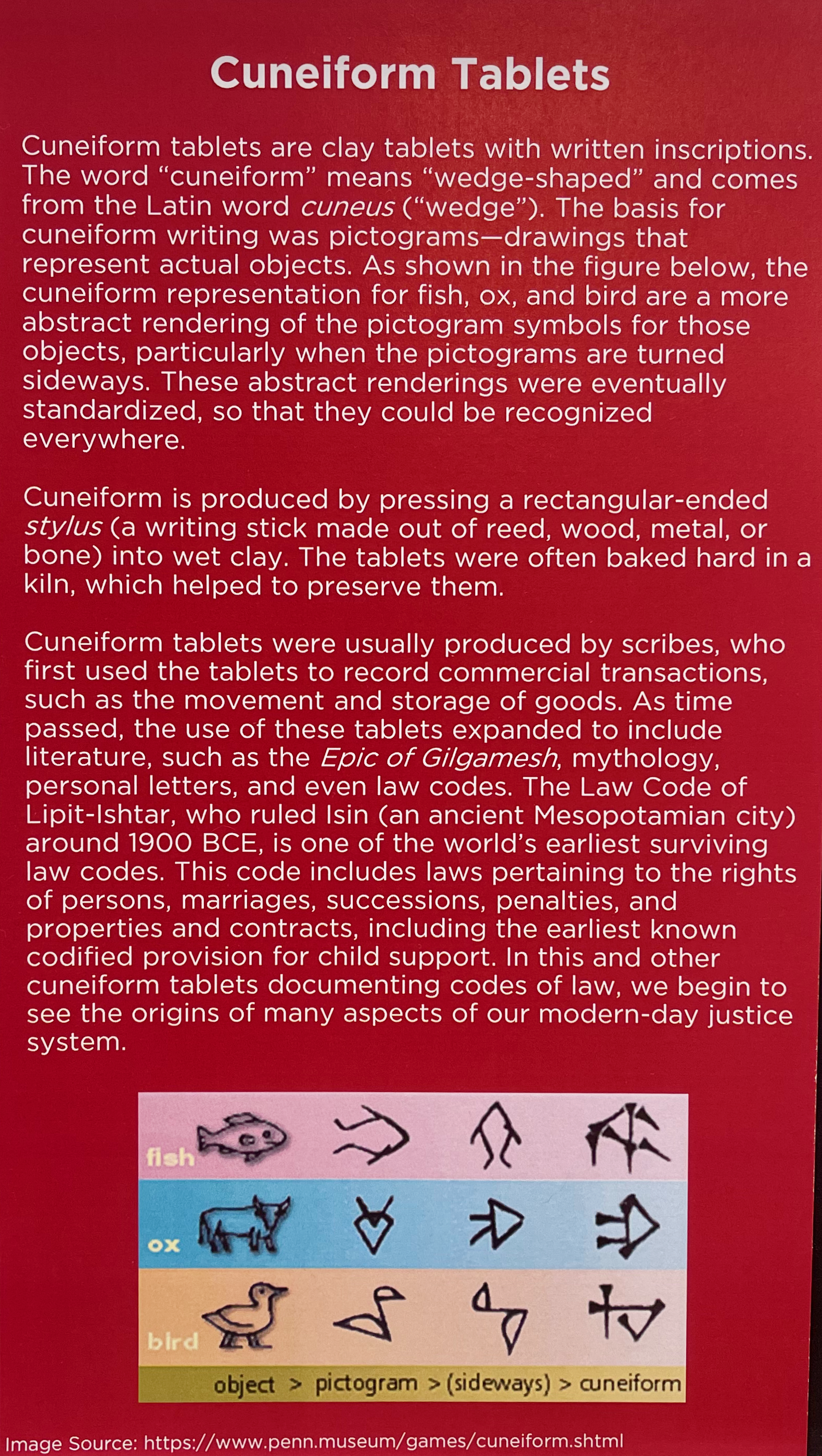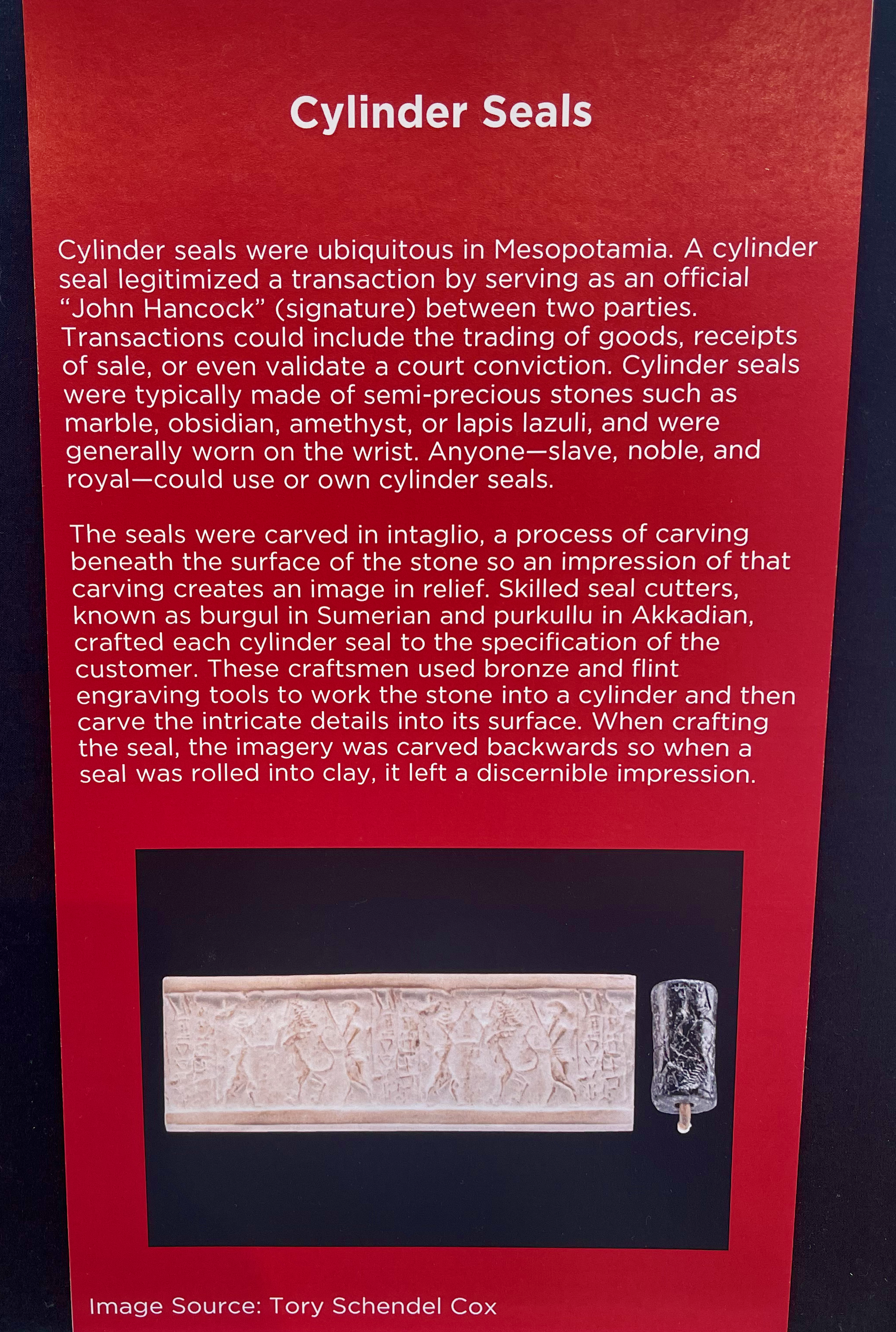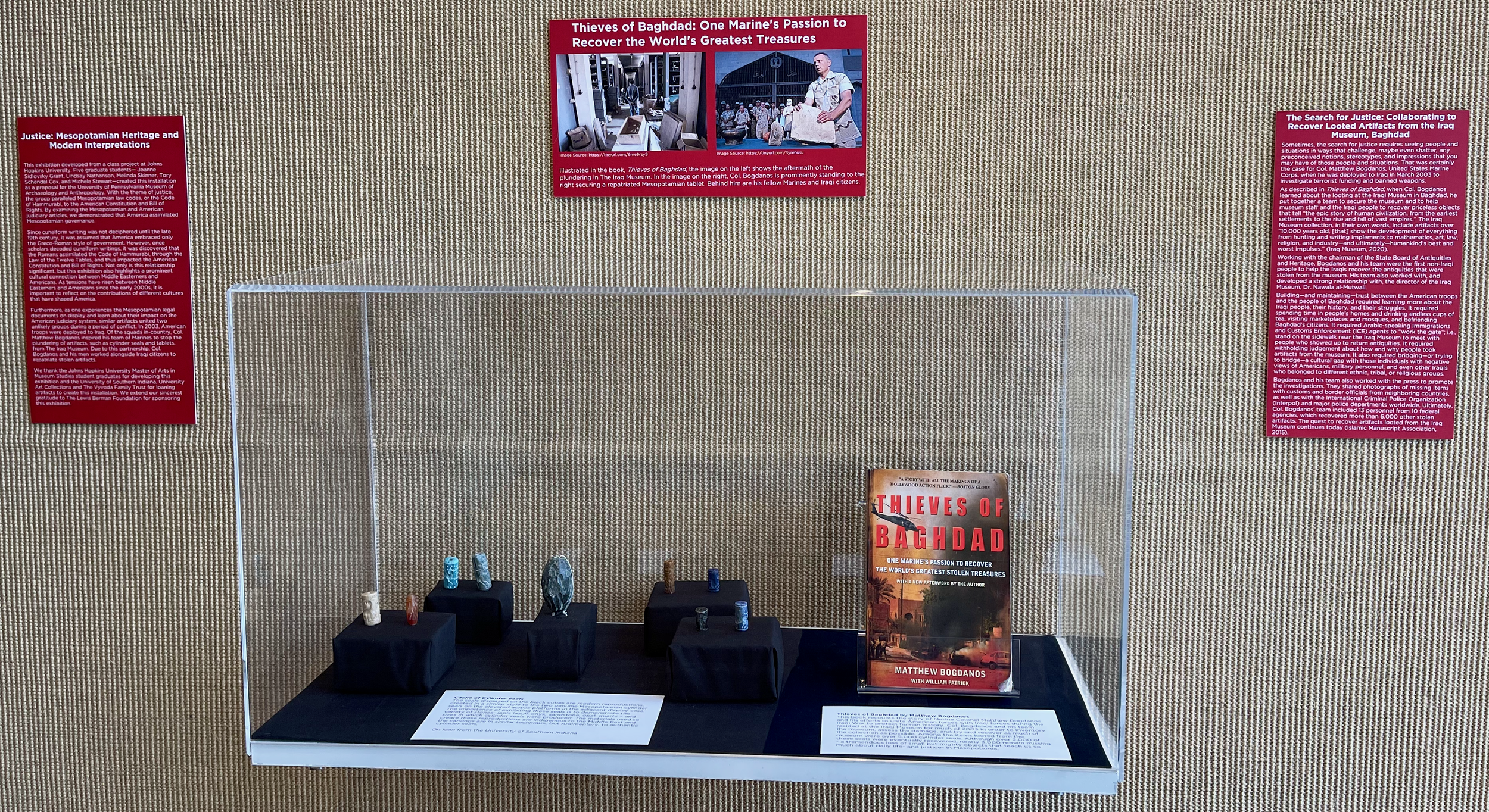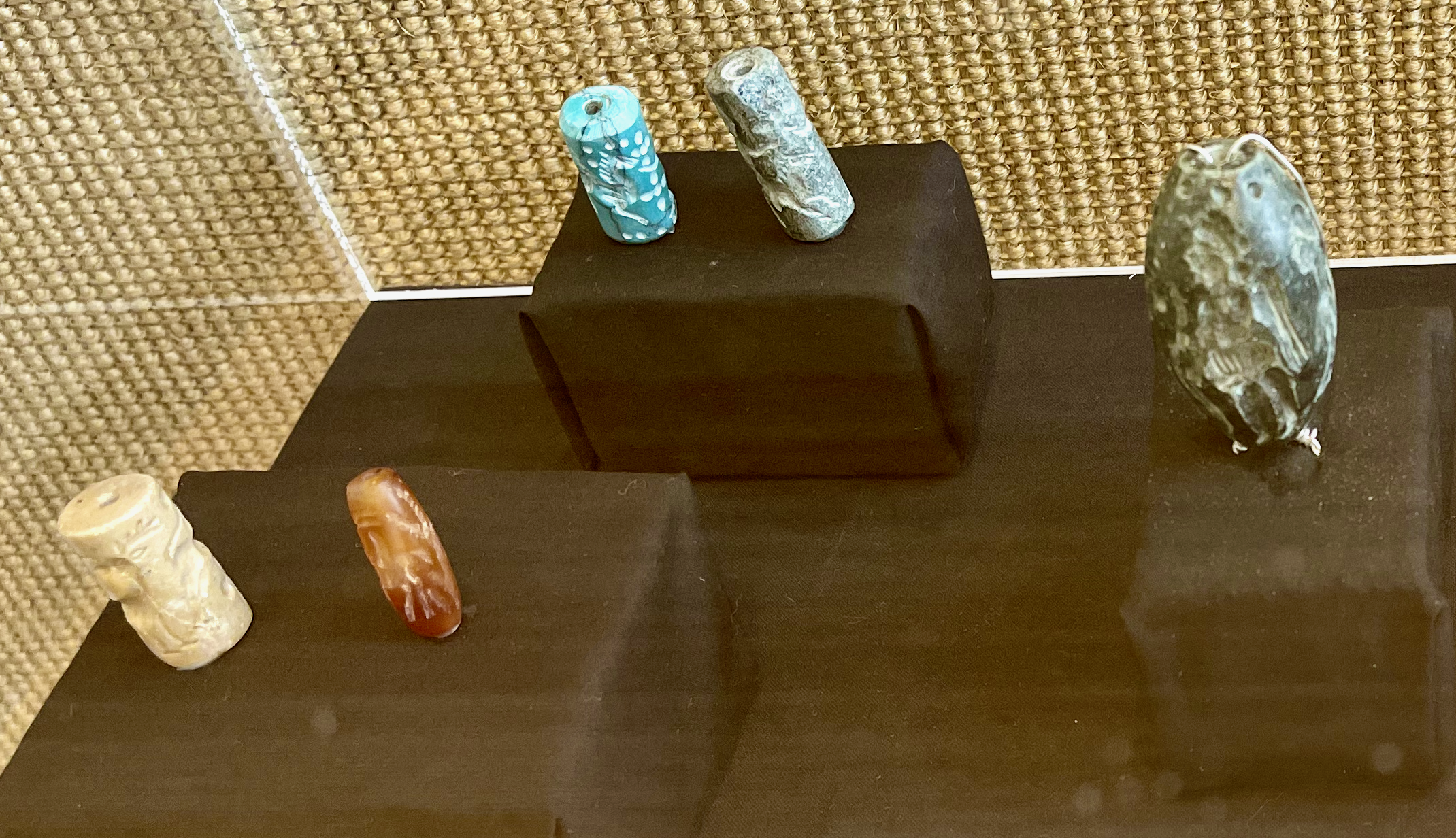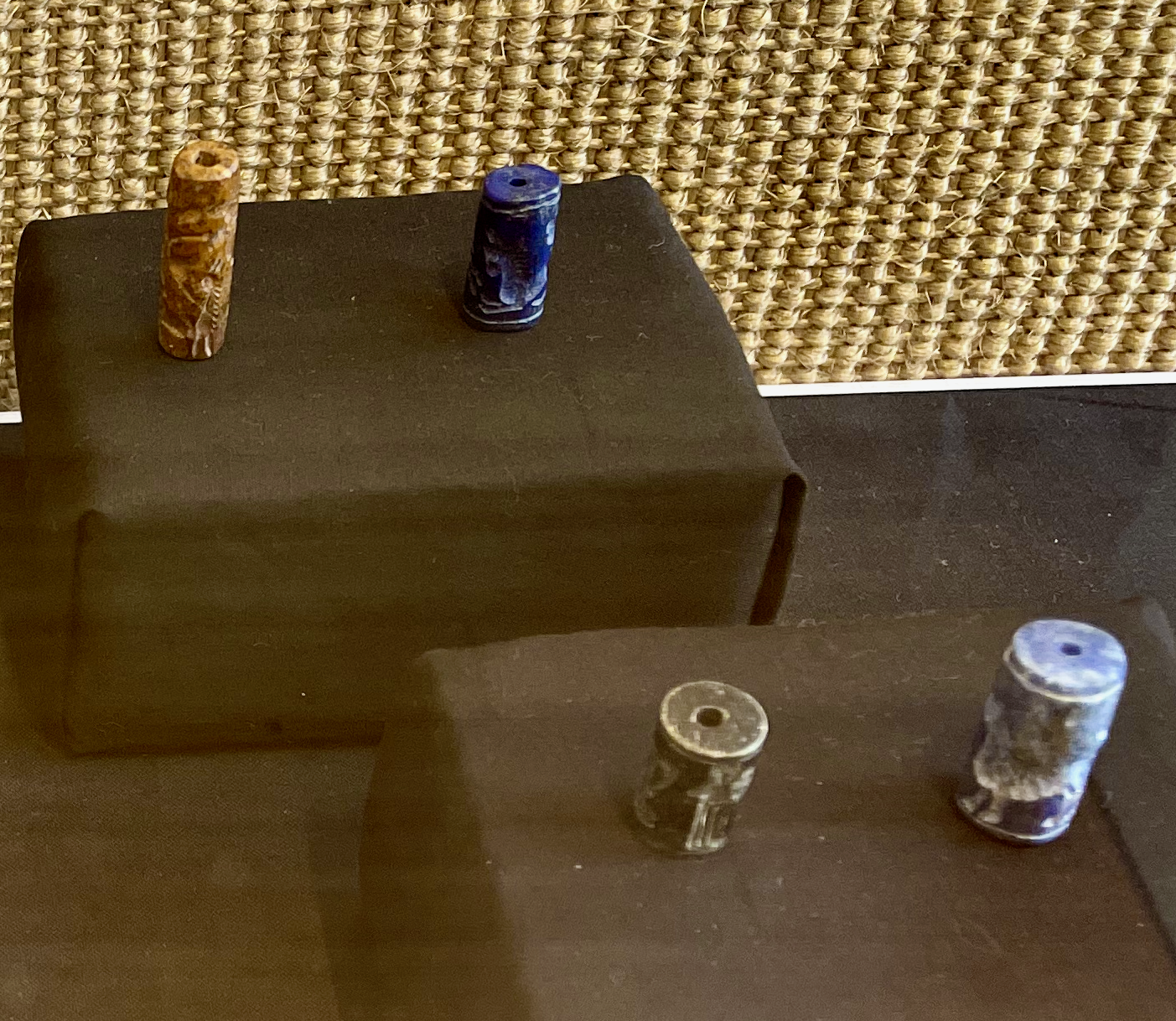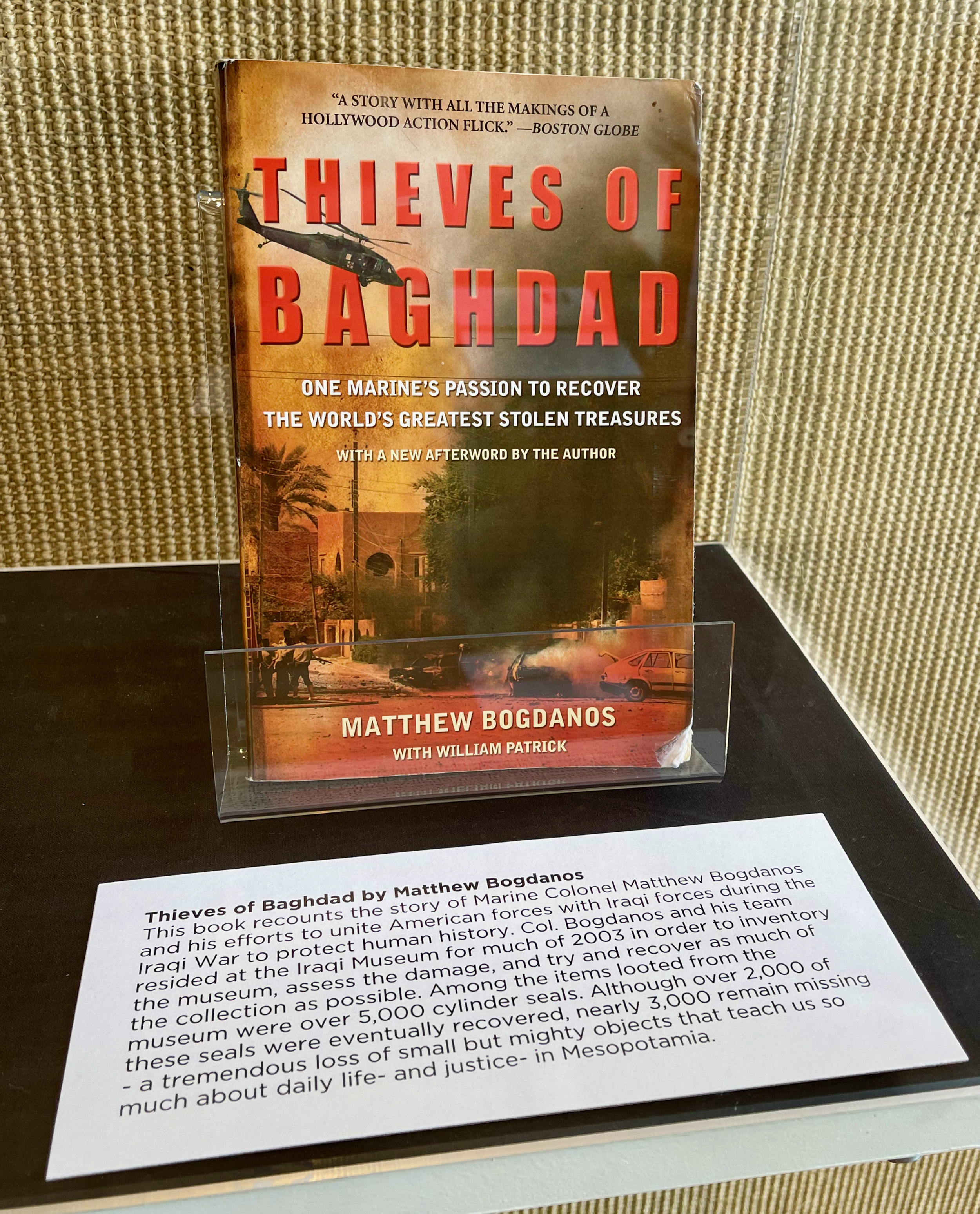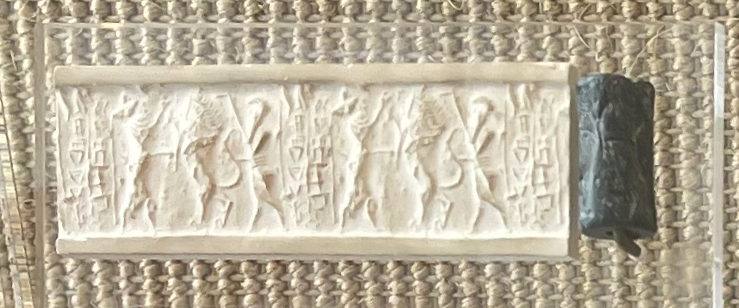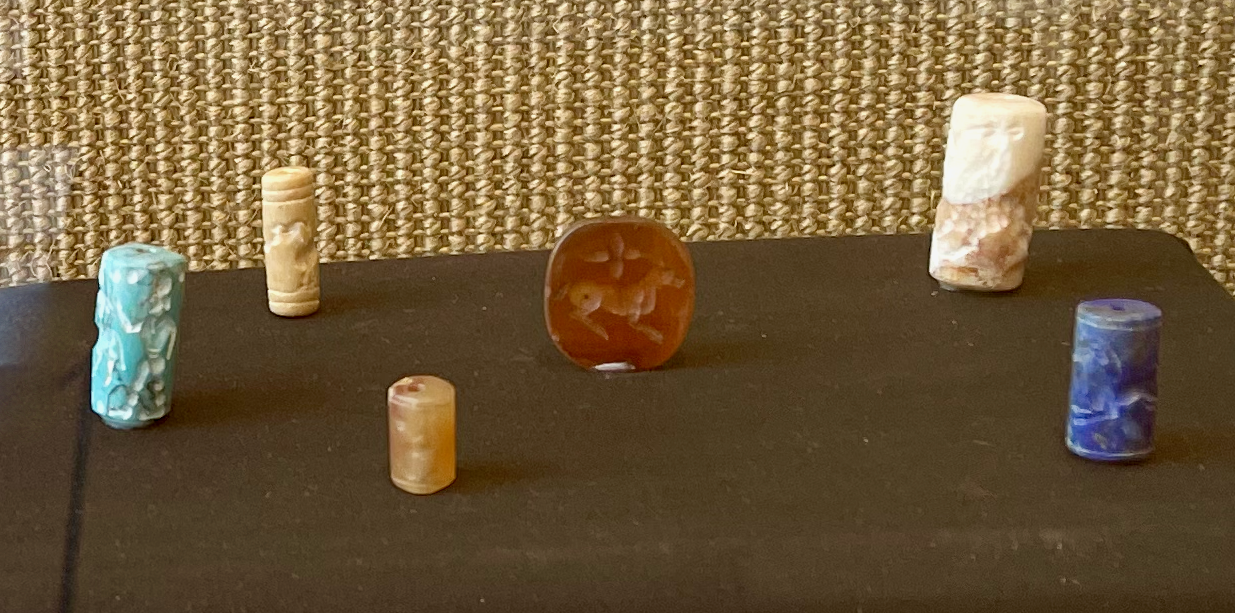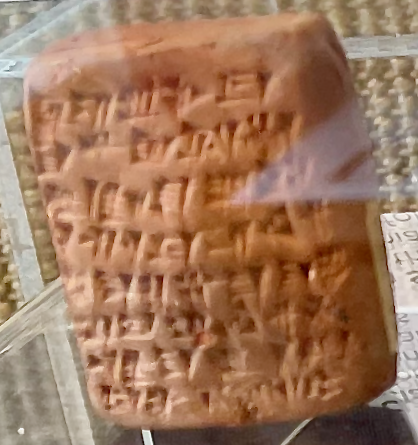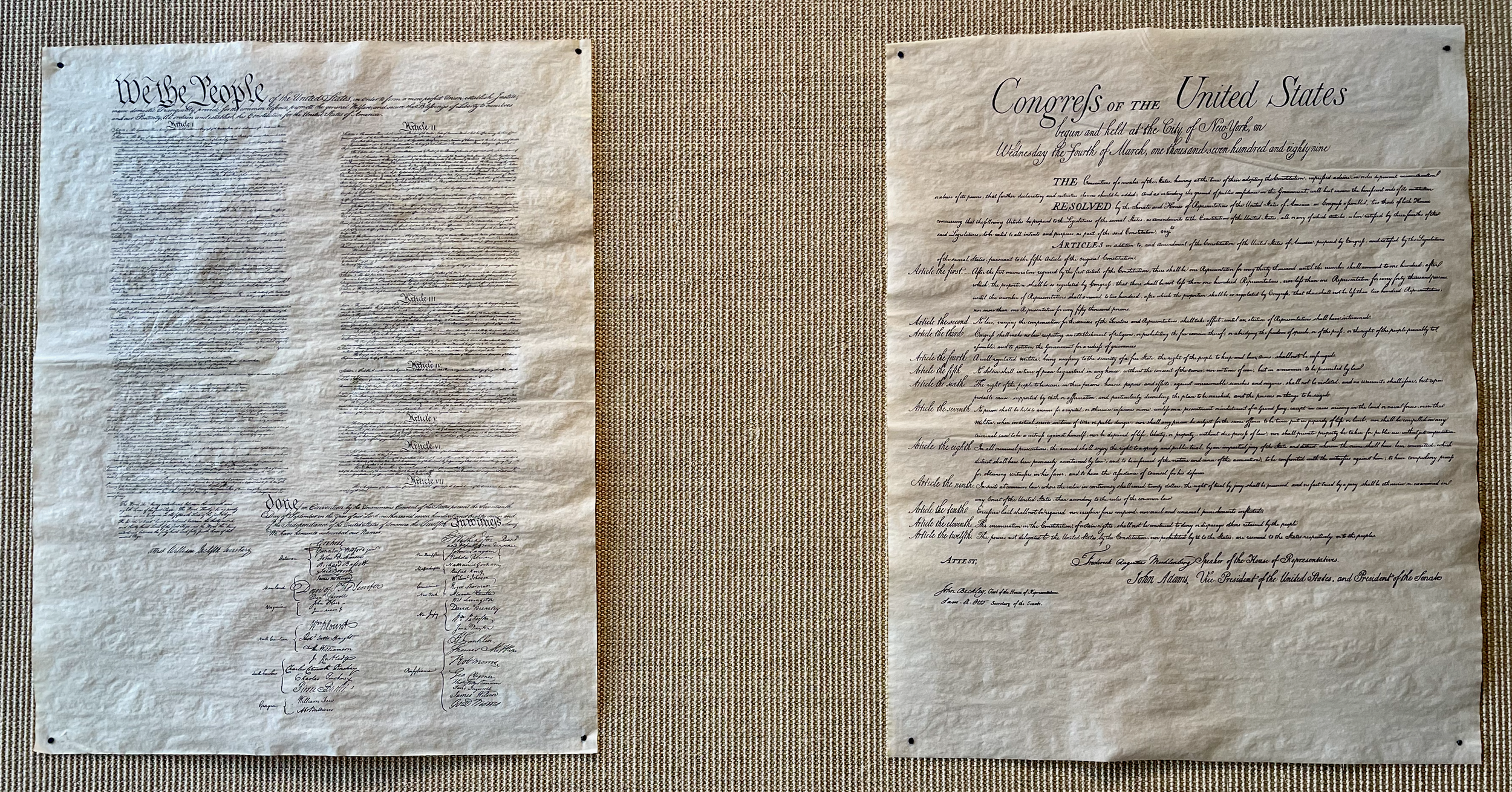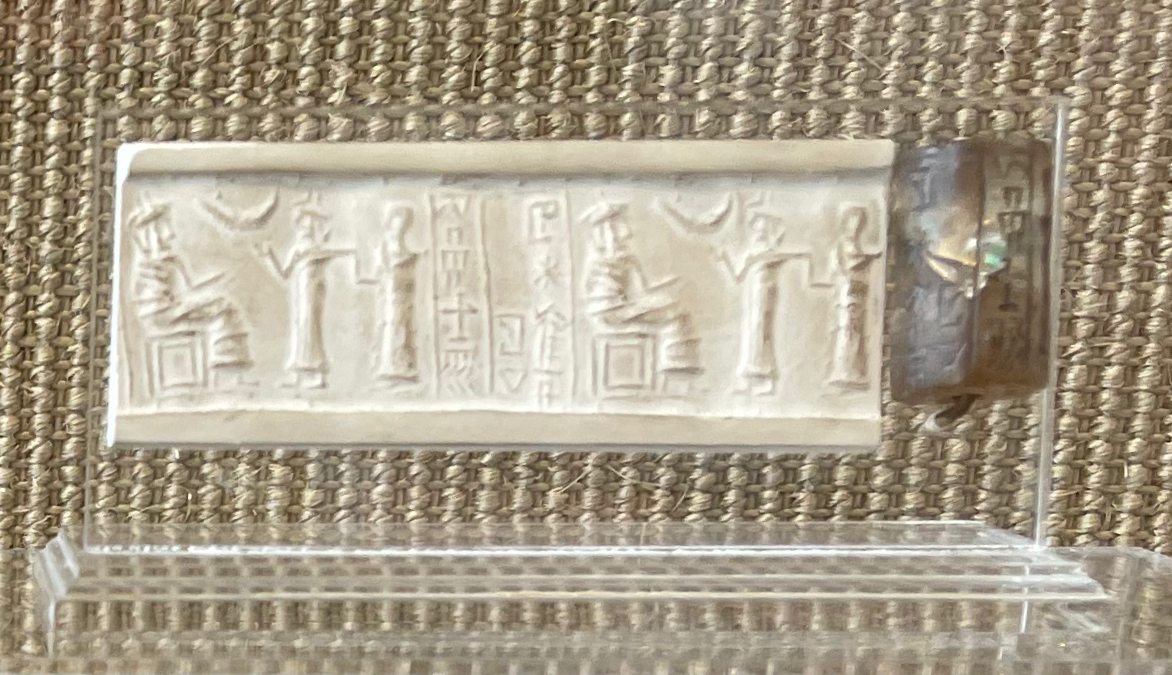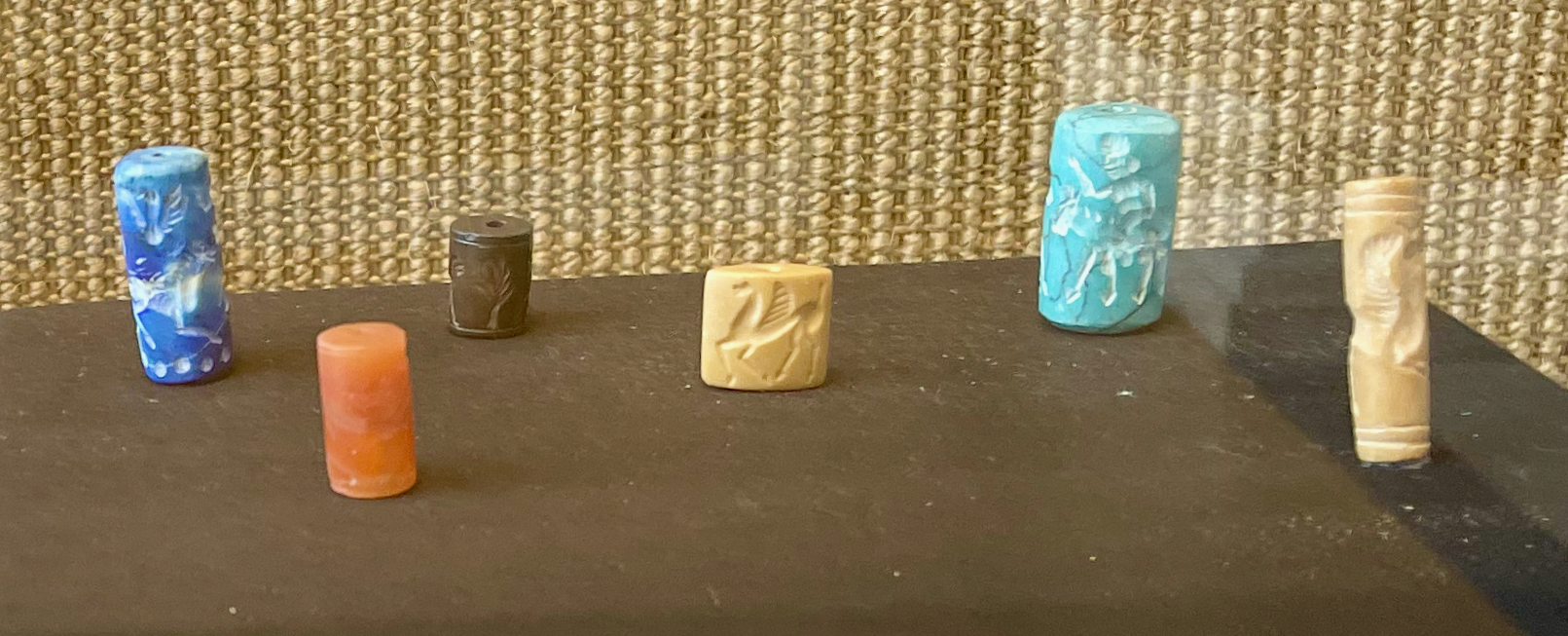Behind the Scenes with the Johns Hopkins University Masters in Museum Studies Students
Introduction
In the Johns Hopkins master’s in museum studies program, one of the courses a student can enroll in is Exhibition Strategies. The purpose of the class is to introduce the diverse strategies and approaches used in exhibition planning, development, and implementation. Also, students spend much of the semester working together in small teams, collaboratively producing a comprehensive exhibition project.
In the Fall semester of 2020, I participated in Exhibition Strategies and was partnered with four teammates, Joanne Sidlovsky Grant, Lindsay Nathanson, Melinda Skinner, and Michele Stewart. In the course, we were “mock professionals” from the Pennsylvania Museum of Archaeology and Anthropology and were expected to utilize the Penn’s permanent collection to create an exhibition focused on the theme of “justice.” To produce this exhibition, our team, otherwise known as the Blue Group, met weekly via ZOOM to design, write, and virtually curate our exhibition.
While working on this exhibition, I learned the University of Southern Indiana had cylinder seals. With our class project in mind and potentially having objects for display, I pitched our Blue Group exhibition project to the Art Committee at the Evansville Museum. The committee voted to allow the exhibition and we were granted space in the John Streetman III Alcove. Once accepted, the University of Southern Indiana generously loaned their objects to the Evansville Museum, and the Blue Group traveled to the Evansville Museum to install the exhibition.
I hope our readers take a moment to learn about our exhibition and the people who made it a reality. Please enjoy the informal discussion in the video at the bottom of this blog and scroll through the photo slideshow.
We appreciate your viewership and hope to see you at the Museum!
Tory Schendel Cox
The Virginia G. Schroeder Curator of Art
About the Exhibition
Justice: Mesopotamian Heritage and Modern Interpretations
Generously Sponsored by The Lewis Berman Foundation
This exhibition developed from a class project at Johns Hopkins University. Five graduate students— Joanne Sidlovsky Grant, Lindsay Nathanson, Melinda Skinner, Tory Schendel Cox, and Michele Stewart—created this installation as a proposal for the University of Pennsylvania Museum of Archaeology and Anthropology. With the theme of justice, the group paralleled Mesopotamian law codes, or the Code of Hammurabi, to the American Constitution and Bill of Rights. By examining the Mesopotamian and American judiciary articles, we demonstrated that America assimilated Mesopotamian governance.
Since cuneiform writing was not deciphered until the late 19th century, it was assumed that America embraced only the Greco-Roman style of government. However, once scholars decoded cuneiform writings, it was discovered that the Romans assimilated the Code of Hammurabi, through the Law of the Twelve Tables, and thus impacted the American Constitution and Bill of Rights. Not only is this relationship significant, but this exhibition also highlights a prominent cultural connection between Middle Easterners and Americans. As tensions have risen between Middle Easterners and Americans since the early 2000s, it is important to reflect on the contributions of different cultures that have shaped America.
Furthermore, as one experiences the Mesopotamian legal documents on display and learn about their impact on the American judiciary system, similar artifacts united two unlikely groups during a period of conflict. In 2003, American troops were deployed to Iraq. Of the squads in-country, Col. Matthew Bogdanos inspired his team of Marines to stop the plundering of artifacts, such as cylinder seals and tablets, from The Iraq Museum. Due to this partnership, Col. Bogdanos and his men worked alongside Iraqi citizens to repatriate stolen artifacts.
We thank the Johns Hopkins University Master of Arts in Museum Studies student graduates for developing this exhibition and the University of Southern Indiana, University Art Collections, and The Vyvoda Family Trust for loaning artifacts to create this installation. We extend our sincerest gratitude to The Lewis Berman Foundation for sponsoring this exhibition.
Meet the Johns Hopkins University Master of Arts in Museum Studies Graduate Students
Joanne Sidlovsky Grant
Biography
My name is Joanne Sidlovsky Grant. I am a graduate student in the Museum Studies program at Johns Hopkins University, focusing on curatorial work – the managing of collections and exhibitions. I also have an M.A. in Classical Archaeology and spent 15 years as a consulting archaeologist. I’m originally from Connecticut, but I’ve been living in the Bay Area- San Francisco and Oakland, California - for the past 18 years.
I am intrigued by past material culture and what we can learn from it; this intrigue is what initially drew me to the field of archaeology. What I liked most about being an archaeologist was working with the artifacts identified through archaeological surveys and excavations—recording them, researching them, and creating exhibitions and other projects with which to share them with a wider audience.
I have been fortunate to apply some of my previous career skills to several Bay Area museums. At the U.S.S. Hornet Sea, Air, and Space Museum, I photograph collection material and link the images to their respective records in PastPerfect, transcribe and edit documents for accessibility purposes, and create finding aids for archival documents. At the Oakland Aviation Museum, I designed an exhibit showcasing Amelia Earhart, her accomplishments, and her connection to Oakland, and continue to manage the museum’s collections, library, and archives. At the Camron-Stanford House, I am inventorying the museum’s collection and designing a new exhibit that will showcase the house’s history as both a private residence and a public museum.
I am honored to be part of the exhibitions team that developed Justice: Mesopotamian Heritage and Modern Interpretations. I look forward to bringing this exhibit to life and gaining further experience in curation, object research, exhibition design, and implementation.
Reflection
This collaborative experience has transitioned successfully from a class project for the Johns Hopkins University Master of Arts in Museum Studies to an actual exhibit, and I am grateful to Tory Schendel Cox and the leadership and board of the Evansville Museum for supporting the bringing of this project to life. The hands-on experience of choosing objects, creating labels, and designing the exhibition was an engaging and educational experience, one that I am proud to be a part of. We hope that our exhibition theme, justice, sparks conversations and reflections about the connections to be found throughout our world.
Lindsay Nathanson
Biography
My name is Lindsay Nathanson and I’m a future collections manager from Philadelphia. I’m inspired by research, storytelling, and the people around me. During my undergraduate experience at the University of Tampa, I didn’t know where I wanted my history degree to take me. I wasn’t quite ready to be a teacher, a lawyer, or a historian. Therefore, I wondered, “What else could a history degree do?” While I was figuring that out, I spent my free time filming, editing, and posting YouTube videos about common and uncommon historical events directed towards college students and other individuals who never really found “history” too interesting. From this experience, I knew two things: 1) the past is my passion, and 2) sharing history can be creative. During my undergraduate senior year, I took my first museum studies course, and I knew this was what I was destined to do in my professional career.
After graduating from the University of Tampa in 2019 with a B.A. in History, I earned my M.A. in Museum Studies from Johns Hopkins University in 2021. Going back to school during a pandemic isn’t all too bad when you signed up for an online program. This degree instilled in me so many things, predominantly where my life is supposed to take me.
When I’m not indulging in American history and art history books and museums, I spend my time collecting newspapers and vinyl, eating any meal in a bowl, and cheering on the 76ers. In the near future, I look forward to working in collections and/or curation at a women's history museum. Today, I enjoy freelance work writing about Philadelphia.
Reflection
When I enrolled in the Exhibition Strategies course at Johns Hopkins University, I thought it was going to be an average semester learning about the best practices of exhibition work. We’d present a few group mock exhibitions and move on to the next semester. As it turns out, I was grouped for my exhibition project with the Curator of Art at the Evansville Museum. Our “average semester” was now the root for a future exhibition… and here we are!
The opportunity that Tory pulled together for me, and this group is a once-in-a-lifetime experience that a student can only imagine happening. The Evansville Museum of Arts, History and Science is a gem of an institution, and I wouldn’t have discovered it if it weren’t for Tory. How many people help to put on an exhibition before they even work full time in a museum? Not many.
Sharing the narrative of Mesopotamian people and their lifestyle all in the context of America and our birth as a nation is the wildest crossover ever. Yet, it all makes so much sense. This portrayal of our group connected together is something that needs to be shared with the world. The fact that it starts at the Evansville Museum is beyond appropriate and special. I hope this exhibition encourages patrons to relate to others, empathize with them, and come together as a community.
Melinda Skinner
Biography
I earned an undergraduate degree in Archaeology and Art History at Hood College in Frederick, Maryland. Since undergrad, I knew that I wanted to work with objects and artifacts and thought archaeology would make this happen. However, after graduation, I began thinking about how I wanted to interact with collection objects and decided that going on excavations was not for me. Thus, I took a year off and found the museum field was more up my alley. I wanted to research objects, cultures, and other documents.
With this realization, I earned a Master’s in Museum Studies at Johns Hopkins University. During school, I focused my classes on more of the collections management part of museums rather than the educational or visitor services. My final goal is to earn a position within a collection or archives and to manage and keep track of the various objects and documents stored within a museum.
While in the Johns Hopkins program, I worked my way through school as a server/bartender and have completed museum exhibition internships, both physical and virtual. My most recent work revolves around the Annapolis Maritime Museum, where I work part-time as a Museum Associate. My work focuses on creating a virtual exhibition about the working women on the Eastport docks during the first half of the 20th century. Also, I volunteer at the Walter’s Art Museum and guide patrons to the new exhibitions and keep track of their feedback during their visit for community engagement opportunities.
Reflection
When I was younger, I did not appreciate museums or their collections as much as I do today. My appreciation solidified at Johns Hopkins University because I learned about the inner workings of a museum. While in the program, I became passionate about collections management. Due to this realization, I was excited to be elected the collections manager for this class project.
This exhibit has been the first stepping-stone to beginning my career within the museum field. It was a surprise to me when Tory came to us and said that she could make this exhibit a reality and invited us all down to help put it together. After that, I knew I wanted to come and explore this first and up-close opportunity to see how an exhibit came to life. Though I have continued my experiences outside of this one, it will remain the first.
Creating this exhibit has given me an authentic look at how school differs from what practically happens for an exhibition to come to life. I learned how to research items through all kinds of sources and use the found information to create an accurate, informative exhibit for the people of Evansville. This project often had difficulties as it started online and often ran late into the night but became well worth it when we presented our final project.
This experience has been great and has allowed me to get closer to ancient artifacts. Also, the topic of Mesopotamia and its connection to American governance doesn’t always get talked about and might not be known to a large portion of the population. Since museums are safe spaces, this venue was well-suited to present this idea and to share a challenging and complicated topic. I am glad to be a part of this project, beginning to end.
Michele Stewart
Biography
My name is Michele Stewart and I graduated from Johns Hopkins University in May 2021 with a Master of Arts in Museum Studies. I earned my Bachelor of Arts in Classics from the University of Texas at San Antonio. My undergraduate education emphasized Latin and ancient Roman society and mythology. I have always wanted to bring my love of the ancient world together with my passion for museums. I love history and sharing ideas and information. I enjoy learning about and using multiple platforms to educate and engage and make museums and their collections accessible for all. I am always seeking opportunities to use technology in museums to provide better representations of history. I think that there is an ongoing need for access to the histories of our world. Museums are wonderful places to show that modern people share many of the same experiences as ancient people.
In September of 2021, I became a member of the National Emerging Museum Professionals Network Publishing Committee. I hope to support other emerging museum professionals by creating and promoting resources and publications, both digital and physical. Throughout my time at Johns Hopkins, I gained an appreciation for all the work that collections management entails. I learned a lot about how to manage the information that a museum holds about its collections through collection management systems and other databases. My main focus is on collection management principles, digital asset management, and collection policy and database management. I am always seeking to strengthen my experience and knowledge in the museum industry.
Reflection
Being a member of this exhibition team has been an amazing opportunity. I am so glad that I was able to be a part of the development from the beginning to the end. I have been able to put my museum studies degree to use from research to organization of the exhibit layout to writing labels. My fellow group members have become such a big part of my educational and professional network. Each one of them has taught me something valuable about being a part of a team and being confident as an individual professional. For me, this exhibit started as just another group project and a grade. Through all of our collaboration and the passion of our group leader, Tory, it has become its own fully-fledged museum exhibition.
I have learned so much from this experience. Being immersed in a museum environment helped me see how exhibition work all comes together. Having access to the ancient objects in the exhibit was a dream come true. Now I can say that I have held a human-made object that is five thousand years old! Even the most mundane parts of the process, like preparing labels and arranging the objects, have been a joy. Working with my fellow group members to create labels for the exhibition was a great learning experience. I was able to hone my research, writing, and editing skills in a practical product. Our group’s ability to collaborate in real-time from various locations across the country helped me advance my technical skills in online collaborative tools. The most enjoyable part of the whole process was being able to put my skills and education to use in the creation of a final product. I am so grateful for the experience of creating this exhibit from scratch as well as the support of the Evansville Museum.





